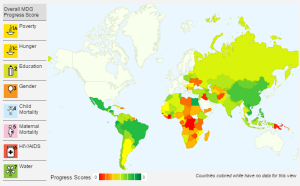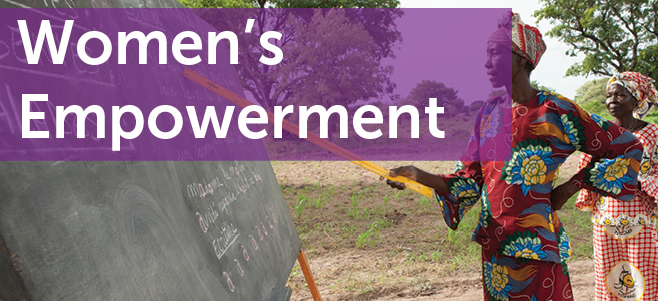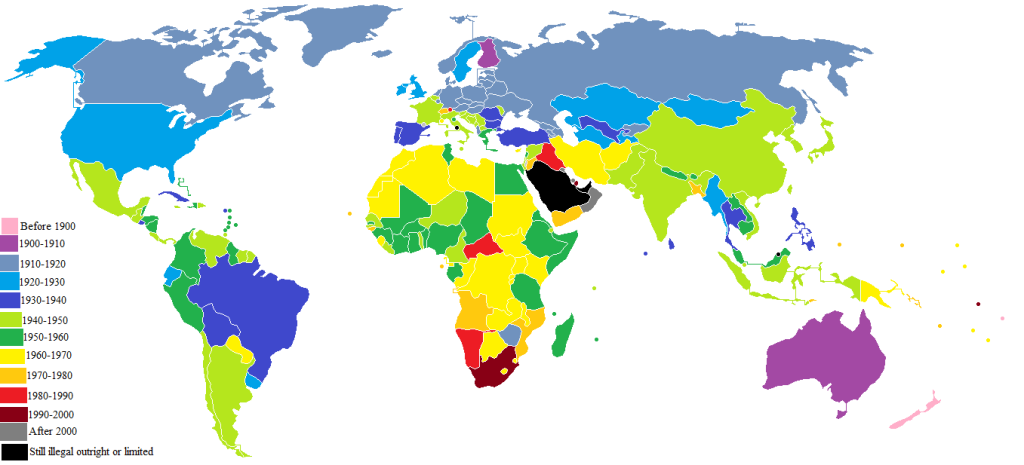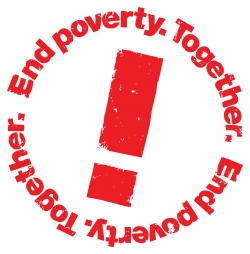Since the creation of the Millennium Development Goals, there has been a lot of speculation about how much progress the MDGs have actually made in eradicating poverty and solving the issues that plague developing countries. This past semester, we have focused on Sub-Saharan Africa. A United Nations 2014 Progress Chart was created that shows the current conditions of these countries after the ten-year period of MDGs ended. According to this report, in Sub-Saharan Africa there is still very high poverty, a very large deficit, high hunger, moderate enrollment in primary schooling, nearly equal enrollment for girls in primary school, a medium share of paid employment for women, moderate representation in national parliaments for women, a high mortality rate of children, a very high mortality rate for maternal mortality, low access to reproductive health, high reduction of HIV/AIDS, moderate mortality involving tuberculosis, low coverage of improved drinking water, very low sanitation, a very high population of slum-dwellers, and a moderate amount of Internet users. Although the progress for each of the goals has been averaged for the purpose of the report, it is still alarming how little improvement there appears to have been.
A country we have discussed in class is Malawi. Malawi has both shown improvement and has stayed the same in categories of the MDGs. In Goal #1: Eradicate Extreme Poverty and Hunger, Malawi has shown little change and as of a report in 2014, the goal was said to be unlikely to be met, although the proportion of ultra poor people was halved by 2014. Goal #2: Achieve Universal Primary Education was also said to be unlikely to be met, although both the net enrollment in primary schooling and the literacy rate slightly increased. Goal #3: Promote Gender Equity and Empower Women was a third goal unlikely to be met, although the ratio of girls to boys in primary and secondary education increased slightly and the proportion of seats held by women in parliament doubled. Goal #5: Improve Maternal Health was the final goal said to be unlikely to be met, although the proportion of births assisted by skilled health professionals increased.
The other 4 goals were said to be likely to be met by 2015. In Goal #4: Reduce Child Mortality, the under-five mortality rate per 1000 decreased drastically and so did the infant mortality rate. In Goal #6: Combat HIV/AIDS, Malaria, and Other Diseases, the HIV prevalence among young pregnant women decreased by 3 times and access to malaria treatment tripled. The death rates associated with tuberculosis also decreased by a lot. In Goal #7: Ensure Environmental Sustainability, the proportion of land covered by forest decreased instead of increasing, but access to improved sanitation and access to an improved water source increased by a large amount. In Goal #8: Develop Global Partnership for Development, both cellular subscriptions and Internet users increased greatly, along with net ODA as a percentage of real GDP.

I think it’s very positive that Malawi has seen such an improvement with half of the goals, but now it’s time to focus on the other 4 goals. I think that a lot of the focus should be put on achieving education and gender equality because with more young people in schools and working, child marriage and the high maternity rate won’t be an issue as they will be contributing to society and not forced into having more children at a young age and having that be their whole life. This will also help the child mortality rate as young women won’t be having children that they can’t care for properly because of low access to healthcare. In my opinion, the progress of each country should be looked at on a case by case basis as every country has different struggles. A different plan needs to be formulated for each country’s specific issues so that the MDGs can be achieved to their full capacity.





 The Convention has helped raise global awareness of discrimination of women in the highest level of global governance. By committing to the Convention, a state must submit a country report every four years. A shortcoming is getting countries to honor their commitments made in closing the gender gap. Even though a state signs on to the commitment, there is no framework to force cooperation. Again, these policies are at a national level, when in reality the local level is where women are more likely to be affected by a gap in women’s rights.
The Convention has helped raise global awareness of discrimination of women in the highest level of global governance. By committing to the Convention, a state must submit a country report every four years. A shortcoming is getting countries to honor their commitments made in closing the gender gap. Even though a state signs on to the commitment, there is no framework to force cooperation. Again, these policies are at a national level, when in reality the local level is where women are more likely to be affected by a gap in women’s rights.



 Denise Dunning of Let Girls Lead work to raise the national marriage age from 15 to 18. In some places in Africa parents will sell the rights to marry their daughter, often at a very young age. This takes social powers away from the women. Raising the minimum age with empower young girls and make them more independent. The strategies are implemented by the governments with the help from not-for-profits.
Denise Dunning of Let Girls Lead work to raise the national marriage age from 15 to 18. In some places in Africa parents will sell the rights to marry their daughter, often at a very young age. This takes social powers away from the women. Raising the minimum age with empower young girls and make them more independent. The strategies are implemented by the governments with the help from not-for-profits.










